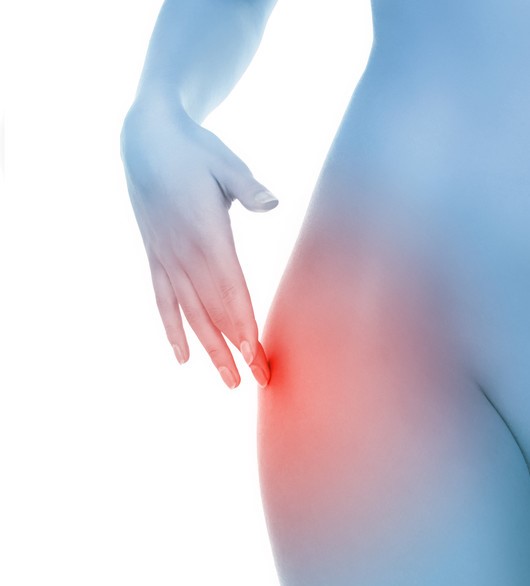Case Study – Female with Lateral hip Pain

This anonymised case study is an example of what I do with real patients. It is published with permission, but the name has been changed.
The Client
Lucy is 44 year old primary school teacher. She is generally fit and healthy. She eats a mixed diet and used to run occasionally, before she had her children, but not often enough to call herself a ‘runner!’ She lives with her husband and has 2 children, 4 & 6 years who were both born normally. She describes her stress levels as ‘normal.’
The Presenting Complaint
Lucy had a 2 year intermittent history of right sided lateral hip pain which has been diagnosed as trochanteric bursitis by her sports massage therapist. The pain is particularly aggravated when she lies on her right side in bed. She sometimes stretches the glute which gives short-term relief. She has had numerous sports massage treatments which give short-term relief. The sports massage is focused on her iliotibial band (IT band) and gluteal region which she describes as brutal but effective!
She presented to me because the pain keeps coming back and she wants to do more running but feels she can’t for fear of making things worse.
Other related history
She also has a long history of intermittent low back pain for which she has previously seen another osteopath who diagnosed her with a short right leg (1cm) and an anterior rotation of the right side of her pelvis.
Boil it down to facts and simple questions.
I start by identifying what I believe are the key facts in the case history and identify what I want to test in the physical examination:
Facts
- Lucy has intermittent right sided lateral hip pain which has been going on for a significant period of time.
- Sports Massage and stretching are effective in dealing with the symptoms in the short-term but are obviously missing the root cause.
- Lucy spends a lot of time standing and bending at work. She has not exercised much for 6 years.
Things to test
- Exact sit of pain – ie give it a poke. This is to make sure I completely understand the location and severity of the pain she has described
- Lower limb strength & Specifically glute strength – I make myself sure that the pain is musculoskeletal and not a trapped nerve as well as comparing strength in the left and right glutes
- I test her hip mobility to rule out a hip problem
- I assess her reported leg length difference to see if it is significantly affecting the quality of her movement. (NB I don’t actually measure leg length difference as this is impossible to do without medical imaging)
Physical Examination
- Palpation (Gentle prodding!) reveals the most painful area is actually the posterior superior edge of the greater trochanter of the hip.
- Lucy has generally good lower limb strength but is significantly weaker in the right gluteals than the left.
- Passive range of motion of the hip is normal.
- The leg length difference does not seem to be affecting thew quality of her movement and seems well within normal.
Working Diagnosis & Treatment
Gluteal tendinopathy.
Treatment
I asked lucy to perform 3 isometric (static) contractions of the gluteals to the point of failure. This had an immediate effect of reducing her pain which confirmed the diagnosis in my mind.
I prescribed the same exercise to be completed at home over the next week
After 2 more appointments at weekly intervals Lucy was reporting a significant improvement and was aware that she was no longer hobbling when she got up from the low chairs or the sofa.
After 1 month lucy she started a couch to 5k programme which she completed 2 weeks faster than the programme recommends with no problems in the hip. At this point I discharged her.
Hi Adam
How are you getting on?
I hope you’re well and keeping well.
Best regards,
Dave